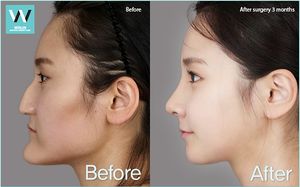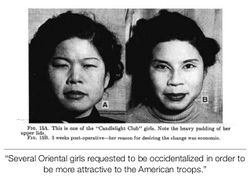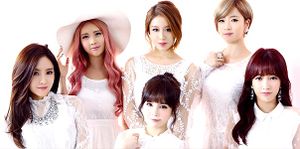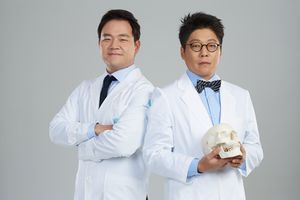GRSJ224/Medicalization of Beauty in South Korea
Introduction
South Korea's Cosmetic Surgery Industry
Seoul, South Korea, is the plastic surgery capital of the world, with more procedures per capita than any other nation.[1] It has been reported that about 1 in 5 South Korean women have undergone some type of cosmetic procedure while in the United States of America, only about 1 in 20 women have had cosmetic procedures.[2] South Korea's medicalization of beauty through cosmetic surgery is becoming so common that walking around in public with bandages around your face is seen as a normal occurence and people don't feel ashamed about it. Since cosmetic surgery is so prevalent and accepted in South Korea today, the younger generation specifically, are constantly being pressured and encouraged by family and friends to get procedures done.
The top 3 most common cosmetic surgery procedures done in South Korea are blepharoplasty (double-eyelid surgery), rhinoplasty (nose reshaping), and V-line jaw reduction.[3] Cosmetic surgery is so popular in South Korea that it has become a social norm for everyone of all ages, with the highest number of procedures being done on millennial. Due to the growing popularity of cosmetic surgeries in South Korea, it has people from around the world talking about it and even flying there to get procedures done themselves.
History
Dr. David Ralph Millard and the Genesis of Cosmetic Surgery in South Korea
From 1950 to 1953, an American military surgeon, Dr. David Ralph Millard, performed reconstructive plastic surgery on war-wounded soldiers and patients with deformities such as cleft lip.[4] His reconstructive surgery work was to help soldiers fix their wounded bodies to look more “normal” and for people to be able to function more efficiently (e.g. fixing a cleft lip). It wasn't until Millard was reconstructing eyebrows for burn victims that he considered altering the human eye from "Oriental to Occidental." [2] This changed his work from being solely reconstructive plastic surgery which is done to restore function or normal appearance by reconstructing defective organs or parts[5] to cosmetic surgery which is reconstructing perfectly functioning features of an individual to look more "appealing". From performing blepharoplasty (double-eyelid surgery) on South Korean citizens, Millard felt that he was composing a humanitarian act by building a reputation for helping them become more acceptable to Americans.[6] Millard also introduced rhinoplasty for beauty purposes from what he discovered from fixing patients with a cleft lip. He transplanted cartilage into the nose to make it appear taller which is a common feature in European ethnicities. His intentions for cosmetic surgery was to allow Korean's to blend in better to the West, reflecting American — particularly white American — dominance. [1] Many of Millard's patients were women in the sex trade, electing to go under the knife in order to increase their appeal to American customers [2] which has now spread to the entire nation.
Social Influence and Parent Pressuring
K-Pop Stars and Celebrities
With South Korean K-Pop stars and celebrities seen on television, social media, and on advertisements posted everywhere, it further normalizes medicalization of beauty through cosmetic surgery. Like Western magazines and celebrities looking "perfect" and relatively similar, Korean advertisement has an influence on their audience and makes them feel self conscious of their own appearance. Although some younger South Korean celebrities haven't had any cosmetic surgery procedures, they often get pressured into it and end up getting common procedures done to the point where they all have similar features. There is nothing wrong with their appearance but smaller, higher and more prominent noses, double-eyelids, and a sharper jaw line has become the most attractive and desired features in South Korea which has lead more and more people to accept medicalizing beauty.
Pressure from Family and Friends
The influence of Cosmetic surgery is South Korea has become so big that family and friends would constantly point out an individual's "imperfections" and suggests that they would look better if they had cosmetic surgery to "fix" it. While children receiving plastic surgery in America is considered a taboo, parents in Korea encourage their children to go under the knife and often gift them with plastic surgery after graduation. [7] Some parents even force their children to have cosmetic surgery calling them "ugly" because they think that is the best for their children's future. Cosmetic plastic surgery has been embedded so deep into South Korean culture that is seems as if natural Korean facial features have become something which appears to be a "deformity" that needs surgery and medical attention to fix. Many South Korean's go under the knife after high school graduation so they have their new faces for a longer time.[3]
Physical Appearance and Job Opportunities
In the South Korean society, there's an idea that the prettier you are, the more benefits you get.[8] Undergoing surgery to achieve an employable face in South Korea has become just as common as going to the gym in America. [2] When applying for jobs in South Korea, attached to your resumé is a photo of yourself and employers judge your appearance since they want "attractive" people to represent their company. This puts a lot of pressure on South Korean citizens because their physical appearance is often times a deciding factor of whether they can get a job or not. After struggling to find a job, individuals often go to cosmetic surgeons to get procedures done to make them look more "employable".
Dominance of Men in the Medical Industry
Studies in Korea typically position cosmetic surgery as conformity to patriarchal versions of femininity in order to maximize women’s chances of success in marriage and the economy. [9] This is due to how cosmetic surgery was introduced to South Korea as well as the dominance by males in the industry. Similar to other countries, men make up about 90% of South Korea's plastic surgeons. [10] Thus, the procedures that are done are derived from their patient's requirements and essentially, the surgeon's perception of beauty. Since men dominate the cosmetic industry in South Korea, they are the ones who can determine ideal beauty standards of women which influences many Korean women to get these procedures done. To this day, it is clear that South Koreans conform to patriarchy since female beauty has been undoubtedly medicalized.
Patriarchy in the medical industry and social media encouraging cosmetic surgery, has lead South Korean citizens to think that their natural features are not beautiful and problematic to the point where they need to seek medical help for it. More and more South Korean's are becoming addicted to cosmetic surgery as they want to look better which is extremely concerning. The pressure to look "beautiful" and the encouragement to get cosmetic surgery may be the cause of mental illnesses such as body dysmorphic disorders where an individual is never satisfied by their own physical appearance. Since cosmetic surgery has become so common, people don't think that they have this disorder and it doesn't seem like surgeons are concerned about it. Instead of addressing potential illnesses, patriarchal medicine in the form of cosmetic surgery seems to be encouraging it and making it worse for the nation.
Controversy
Western Influence
There is a big controversy on whether the top 3 cosmetic surgery procedures in South Korea are done so that it can make a non-Western individual look more "Western". Western news reports and mass media are talking about the homogenization and Westernization of Korean women’s faces, suggesting that South Korean surgeries aim to produce faces characterized by big eyes, a sharp nose and slender cheeks.[11] With that said, it seems that South Korean people, and other Asians, modify their facial features to mimic Caucasian features. Since the beginning of blepharoplasty (double-eyelid surgery) was to make eyes appear larger and more Western looking and many Koreans living in Western countries wanted this procedure to help them fit in, that has become undeniable evidence that this cosmetic procedure was done to fit into the definition of "Western beauty standards". Multiple historians have cited Millard and his publications as clear evidence for Western influence on modern beauty ideals in South Korea. [2]
Although many critics use Millard as proof that these cosmetic surgeries came from the intention to make Asians look more Western, many Asian plastic surgeons claim that these procedures are meant to retain their patients' ethnicities and make them generally more attractive. [12] This topic becomes a debate when people question what is considered "more attractive" and where these standards of attractive features derive from.
No matter what the reason may be, cosmetic surgery continues to grow in South Korea and the population is rapidly eradicating natural Korean physical features while simultaneously looking more similar to one another due to having the same medical procedures.
References
- ↑ Jump up to: 1.0 1.1 Baer, D. (2015, October 06). The most popular plastic surgery operation in South Korea has a controversial past. Retrieved April 05, 2017, from http://www.businessinsider.com/the-most-popular-plastic-surgery-in-korea-2015-10
- ↑ Jump up to: 2.0 2.1 2.2 2.3 2.4 Kurek, L. (2015). Eyes wide cut: the American origins of Korea's plastic surgery craze. Wilson Quarterly, 39(4), 2.
- ↑ Jump up to: 3.0 3.1 Marx, P. (2015, March 24). The World Capital of Plastic Surgery. Retrieved April 05, 2017, from http://www.newyorker.com/magazine/2015/03/23/about-face
- ↑ Leem, S. Y. (2015). The Dubious Enhancement: Making South Korea a Plastic Surgery Nation. East Asian Science, Technology and Society,10(1), 51-71. doi:10.1215/18752160-3325203
- ↑ https://www.merriam-webster.com/dictionary/reconstructive%20surgery
- ↑ Thompson, L. (2012). Plastic surgery. Santa Barbara, CA: Greenwood.
- ↑ Waintier, Jennifer. "Korea's Dangerous Obsession with Plastic Surgery." The Chosunilbo Chosun Media, 23 Dec. 2013 Retrieved April 06, 2017
- ↑ Standen, C. (2013, May 14). South Korean Parents Are Making Their Kids Get Plastic Surgery. Retrieved April 07, 2017, from https://www.vice.com/en_us/article/south-korean-parents-are-making-their-kids-get-plastic-surgery
- ↑ Holliday, R., & Elfving-Hwang, J. (2012). Gender, Globalization and Aesthetic Surgery in South Korea. Body & Society, 18(2), 58-81. doi:10.1177/1357034x12440828
- ↑ Raffle , B. (2013, July 25). Why Are All The Plastic Surgeons Men? Retrieved April 10, 2017, from http://www.prleap.com/pr/207181/why-are-all-the-plastic-surgeons-men
- ↑ Leem, S. Y. (2016). The anxious production of beauty: Unruly bodies, surgical anxiety and invisible care. Social Studies of Science, 46(1), 34-55. doi:10.1177/0306312715615971
- ↑ Youn, D. A. (2013, June 26). Asia's ideal beauty: Looking Caucasian. Retrieved April 05, 2017, from http://www.cnn.com/2013/06/25/health/asian-beauty/




